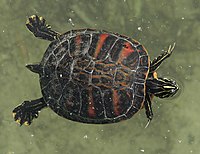Florida red-bellied eared turtle
| Florida red-bellied eared turtle | ||||||||||||
|---|---|---|---|---|---|---|---|---|---|---|---|---|

Florida red-bellied eared turtle ( Pseudemys nelsoni ) |
||||||||||||
| Systematics | ||||||||||||
|
||||||||||||
| Scientific name | ||||||||||||
| Pseudemys nelsoni | ||||||||||||
| Carr , 1938 |
The Florida red-bellied ear turtle ( Pseudemys nelsoni ), also known as Nelson's eared turtle , is a turtle belonging to the genus real eared turtle , which belongs to the family of the New World pond turtle . Their occurrence is limited to the Florida Peninsula and the southern part of Georgia .
Appearance
The Florida red-bellied eared turtle is a large, broadly armored turtle with a relatively tall carapace . The head lines are less noticeable than with other eared turtles, but a stripe runs below the eyes, forks, and a branch on each side runs towards the nose. At the edge of the upper jaw there are two small cusps, like small teeth. The marginal shields have a reddish border and black points underneath. The plastron is yellow-orange to reddish and gives the species its name. The front claws of the males are elongated as a courtship instrument. The females of the species are barely larger than the males and reach a length of up to 37.5 centimeters. Older animals melanize with increasing age.
No subspecies of the Florida red-bellied eared turtle are known.
habitat
The relatively small range of the Florida red-bellied eared turtle runs from the Okefenokee Swamp in Georgia to the Everglades . This area is fairly lush with open swamps and vast wetlands. Slowly flowing waters are just as much a part of the habitats as the standing swamps and wetlands.
Way of life
The Florida red-bellied ear turtles are active year round and are often seen basking in the sun. They are the most common turtles in Okefenokee Swamp and Florida Canals.
Males reach sexual maturity at three to four years of age, their plastron is then 17 to 21 cm long. The females do not become sexually mature until they are five to seven years old and are then 26 to 27 cm long. 6 to 31 eggs are laid several times a year and the young hatch after 60 to 75 days.
nutrition
These turtles feed mainly on marsh and aquatic plants , e.g. B. Water hemlock , waterweed , ground nettle , water hyacinth , Arrowhead , duckweed , mermaids herbs , Vallisneria and algae . But they also take carrion, e.g. B. from dead fish to yourself. Young animals also prey on small aquatic insects.
Predators and causes of mortality
Numerous native mammals such as raccoons , otters and skunks are a threat to clutches on land. In the water, the alligators , snapping turtles and large fish are the enemies of the young animals. The very thick and high carapaces of the adult animals allow them to coexist with the common alligators. Even adult alligators cannot crack the shells.
Trade and attitude
In 2003 around 5 million eared turtles of the genus Pseudemys were exported from the USA. A more precise specification by species is not possible in the export statistics, however, in addition to the Florida red-bellied ear turtle, only the common ear turtle and the peninsula ear turtle are exported. It can therefore be assumed that numerous specimens of the Florida red-bellied ear turtle came onto the market as pets or as food. The exporters indicated that the majority of the animals came from breeding.
literature
- AF Carr Jr .: Pseudemys nelsoni, a new turtle from Florida. Occ. Pap. Boston Soc. Nature. Hist., 8, pp. 305-310, 1938 (first description)
- Carl H. Ernst, Jeffrey E. Lovich: Turtles of the United States and Canada . Johns Hopkins University Press , Baltimore 2009, pp. 364-399, ISBN 0-8018-9121-3
- Kurt Buhlmann, Tracey Tuberville, J. Whitfield Gibbons: Turtles of the Southeast . University of Georgia Press, Athens 2008, ISBN 0-8203-2902-9
- RN Reed and JW Gibbons: Conservation status of live US nonmarine turtles in domestic and international trade - a report to: US Department of the Interior and US Fish and Wildlife Service. Savannah River Ecology Lab, Aiken, South Carolina 2004
Individual evidence
- ↑ Carl H. Ernst, RGM Altenburg and RW Barbour: Pseudemys nelsoni ( page no longer available , search in web archives ) Info: The link was automatically marked as defective. Please check the link according to the instructions and then remove this notice. at Turtles of the World, Chapter: Synonyms
- ↑ M. Kramer and U. Fritz: Courtship of the turtle, Pseudemys nelsoni. J. Herpetol., 23, pp. 84-86, 1989
- ↑ RL Lardie: Notes on the courtship, eggs, and young of the Florida red-bellied turtle, Chrysemys nelsoni. HISS News-J., 1, pp. 183-184, 1973
- ↑ KA Bjorndal, AB Bolten, CJ Lagueux and DR Jackson: Dietary overlap in three sympatric congeneric freshwater turtles (Pseudemys) in Florida. Chelonian Conserv. Biol., 2, pp. 430-433, 1997
- ↑ Export of Pseudemys sp. from the United States of America
Web links
- Pseudemys nelsoni at Turtles of the World (engl.)
- Pseudemys.de Information page about keeping the Pseudemys species (German)
- Pseudemys nelsoni in The Reptile Database
- Pseudemys nelsoni inthe IUCN 2013 Red List of Threatened Species . Posted by: van Dijk, PP, 2010. Accessed February 1, 2014.


